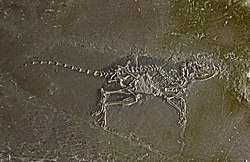Portal:Paleontology
|
The Palaeontology Portal
Introduction Paleontology (/ˌpeɪliɒnˈtɒlədʒi, ˌpæli-, -ən-/ PAY-lee-on-TOL-ə-jee, PAL-ee-, -ən-), also spelled palaeontology or palæontology, is the scientific study of life that existed prior to, and sometimes including, the start of the Holocene epoch (roughly 11,700 years before present). It includes the study of fossils to classify organisms and study their interactions with each other and their environments (their paleoecology). Paleontological observations have been documented as far back as the 5th century BC. The science became established in the 18th century as a result of Georges Cuvier's work on comparative anatomy, and developed rapidly in the 19th century. The term has been used since 1822 formed from Greek παλαιός ('palaios', "old, ancient"), ὄν ('on', (gen. 'ontos'), "being, creature"), and λόγος ('logos', "speech, thought, study"). Paleontology lies on the border between biology and geology, but it differs from archaeology in that it excludes the study of anatomically modern humans. It now uses techniques drawn from a wide range of sciences, including biochemistry, mathematics, and engineering. Use of all these techniques has enabled paleontologists to discover much of the evolutionary history of life, almost all the way back to when Earth became capable of supporting life, nearly 4 billion years ago. As knowledge has increased, paleontology has developed specialised sub-divisions, some of which focus on different types of fossil organisms while others study ecology and environmental history, such as ancient climates. (Full article...) Selected article on the prehistoric world and its legacies
Gryposaurus (meaning "hooked-nosed (Greek grypos) lizard"; sometimes incorrectly translated as "griffin (Latin gryphus) lizard") was a genus of duckbilled dinosaur that lived about 83 to 75.5 million years ago, in the Late Cretaceous (late Santonian to late Campanian stages) of North America. Named species of Gryposaurus are known from the Dinosaur Park Formation in Alberta, Canada and the Lower Two Medicine Formation in Montana and the Kaiparowits Formation of Utah in the United States.
Gryposaurus is similar to Kritosaurus, and for many years was regarded as the same genus. It is known from numerous skulls, some skeletons, and even some skin impressions that show it to have had pyramidal scales pointing out along the midline of the back. It is most easily distinguished from other duckbills by its narrow arching nasal hump, sometimes described as similar to a "Roman nose," and which may have been used for species or sexual identification, and/or combat with individuals of the same species. A large bipedal/quadrupedal herbivore around 9 meters long (30 ft), it may have preferred river settings. (see more...) Did you know?
General images -The following are images from various paleontology-related articles on Wikipedia.
Selected article on paleontology in human science, culture and economicsThe Bone Wars is the name given to a period of intense fossil speculation and discovery during the Gilded Age of American history, marked by a heated rivalry between Edward Drinker Cope and Othniel Charles Marsh. The two paleontologists used underhanded methods to out-compete the other in the field, resorting to bribery, theft, and destruction of bones. The scientists also attacked each other in scientific publications, attempting to ruin the other's credibility and cut off his funding. Originally colleagues who were civil to each other, Cope and Marsh became bitter enemies after several personal slights between them. Their pursuit of bones led them west to rich bone beds in Colorado, Nebraska, and Wyoming. From 1877 to 1892, both paleontologists used their wealth and influence to finance their own expeditions and to procure services and fossils from dinosaur hunters. By the end of the Bone Wars, both men exhausted their funds in fueling their intense rivalry. Cope and Marsh were financially and socially ruined by their efforts to disgrace each other, but their contributions to science and the field of paleontology were massive; the scientists left behind tons of unopened boxes of fossils on their deaths. The feud between the two men led to over 142 new species of dinosaurs being discovered and described. The products of the Bone Wars resulted in an increase in knowledge of ancient life, and sparked the public's interest in dinosaurs, leading to continued fossil excavation in North America in the decades to come. Several historical books and fictional adaptations have also been published about this period of intense paleontological activity. (see more...) On this day...May 18:
Selected image
CategoriesTopicsGeneral - Paleontology - Fossil - Evolution - Extinction Quality ContentFeatured paleontology articles
- Achelousaurus
- Acrocanthosaurus
- Albertosaurus
- Allosaurus
- Amargasaurus
- Ankylosaurus
- Apatosaurus
- Archaeopteryx
- Baryonyx
- Carnotaurus
- Catopsbaatar
- Ceratosaurus
- Chicxulub Crater
- Compsognathus
- Cretaceous–Tertiary extinction event
- Daspletosaurus
- Deinocheirus
- Deinonychus
- Deinosuchus
- Dilophosaurus
- Dinosaur
- Diplodocus
- Dromaeosauroides
- Edmontosaurus
- Elasmosaurus
- Giganotosaurus
- Gorgosaurus
- Herrerasaurus
- Iguanodon
- Istiodactylus
- Lambeosaurus
- List of dinosaur genera
- Majungasaurus
- Massospondylus
- Megalodon
- Nemegtomaia
- Nigersaurus
- Opisthocoelicaudia
- Paranthodon
- Parasaurolophus
- Plateosaurus
- Psittacosaurus
- Seorsumuscardinus
- Spinosaurus
- Stegosaurus
- Stegoceras
- Styracosaurus
- Tarbosaurus
- Thescelosaurus
- Triceratops
- Tyrannosaurus
- Velociraptor
Things you can doCurrent Paleontology FACs - None yet... WikiProjectsRelated portalsAssociated WikimediaThe following Wikimedia Foundation sister projects provide more on this subject:
Discover Wikipedia using portals |










































